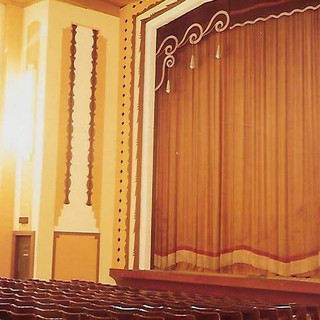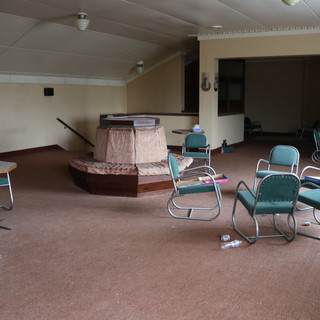
The Heritage Council is considering registering Mudgee’s Regent Theatre as a building of State Significance to be listed on the NSW State Heritage Register. Public comments from any interested party is currently open until Tuesday 8 October.
Email heritagemailbox@environment.nsw.gov.au to share your support to ensure the building is put on the NSW Heritage Register.
The criteria for state heritage nomination can be found here.
We have collated some key information from the Environment website here to outline the Regent meets a number of criteria for State Heritage listing including historical significance, associative significance, social significance, research potential, rarity and representativeness
Statement of Significance “The Regent Theatre is an intact, representative example of an Art Deco, country town theatre from the heyday of the moviegoing phenomenon in New South Wales. It is rare in its degree of intactness which includes original Art Deco fixtures and fittings, and audio and projection equipment of industrial heritage value. The Regent is a rare example of an early childcare facility incorporated into a theatre.
The Regent has research potential in its complete and detailed demonstration of architectural, technical and social aspects of cinema going during the 20th century.
The Regent is of social significance to the regional community of the central west of NSW. It is also esteemed by Architecture and Heritage organisations for its place in the architectural history of NSW.
The theatre is associated with George N Kenworthy, noted theatre architect, who designed some of the finest theatres and Art Deco buildings in Australia and who played a major role in the development of Art Deco in Australia”

Assessment of significance SHR Criteria a) [Historical significance] The Regent Theatre represents an excellent and rare surviving example of a country town theatre that played a key role in the heyday of the movie going phenomenon. The Regent illuminates an aspect of the cultural history of country NSW in demonstrating the importance of cinema in popular culture in the late inter-war period. In NSW, 2040 venues were constructed and 'picture going' was second only to sport as a leisure time activity, impacting on popular taste in fashion, design, language and music. The "golden years" of movie-going lasted from the 1930's to the 1960's, not only in Mudgee but also in numerous towns and cities throughout the country.
From 1937, picture-going grew to become a permanent feature in the entertainment life of the towns of Mudgee, Gulgong, Rylstone and Kandos. The Regent Theatre has provided a regional venue for regular weekly visits to the cinema.
The Movie Theatre Heritage Register for NSW 1896-1996, undertaken by Ross Thorne et al, for the Heritage Office (NSW) and the Australian Heritage Commission, identifies the Regent Theatre Mudgee as belonging to the fifth and final stage of cinema venue development: 1930s construction and/or refurbishment. While this phase is described as often being 'little more than a new front of moulded asbestos cement', in the context of country NSW, the Regent (together with the cinemas at Yass, Tamworth and Scone) is identified as 'equal to the better Sydney suburban examples'.
The children's nursery, within the theatre, is an important and early example of child-care facilities in a public space and a rare example of such a facility associated with a rural cinema.
SHR Criteria b) [Associative significance] The Regent is associated with the work of George Newton Kenworthy, noted cinema architect who designed outstanding theatres in the picture palace genre and some of the finest Art Deco buildings in Australia.
Kenworthy’s work includes three items listed on the State Heritage Register: State Theatre and Former State Shopping Block Including Interiors; Newcastle City Hall and Civic Theatre; The Paragon (Ballroom and Supper room). The Palais Theatre, St Kilda, Melbourne, also designed by Kenworthy, is listed on the Victorian Heritage Register. Through his work in theatre design Kenworthy played a major role in the development of the Art Deco style in Australia.
Further research could illuminate the nature of his early partnership with Henry White; and a better understanding of the extent of his influence.
SHR Criteria d) [Social significance] The Regent has been a focal point of the popular culture of Mudgee and a mecca for visitors and tourists to the region, for generations. The theatre has played an important role socially, both as a venue as well as for its physical form within the urban fabric.

The contemporary community esteem for the Regent, is evidenced by the state-wide response, on social media and in submissions to the local council, opposing its proposed partial demolition and conversion to a hotel. 'Revive the Regent' community group was established to promote retention of the theatre. The efforts of 'Revive the Regent' were recognised with the 2019 National Trust Award for Advocacy.
The joint nomination for listing on the State Heritage Register by the National Trust of Australia, Twentieth Century Heritage Society of NSW and the Institute of Architects (NSW Chapter) is further evidence of a broad, state-wide social value . SHR Criteria e) [Research potential] The Regent Theatre contains numerous items of industrial heritage value in the form of projection and related equipment which have the potential to yield information for a better understanding of the evolution of technical aspects of film projection, sound reproduction and presentation and theatre lighting.
It may be of state heritage significance for its complete and detailed demonstration of architectural, technical and social aspects of cinema going during the 20th century.
The cinema design work of Kenworthy is not as broadly recognised as the work of, his one-time partner, Henry Eli White. The Regent has potential to contribute to a better understanding Kenworthy’s body of work and his importance as a designer in the architectural history of NSW.
SHR Criteria f) [Rarity] With the demolition and/or modification of most of the state’s old picture theatres, the Regent Theatre is now a rare example of a once more numerous building type.
A desktop survey of remaining cinemas in country towns indicates that only seven Interwar cinemas in rural NSW towns retain their original form and architectural and decorative features and still operate as theatres. This is a relatively small number of sites and each intact example is considered rare.
The Regent Theatre is rare as one of three remaining intact theatres in the Inter War Art Deco architectural style (Bingara Roxy, Scone Civic, Mudgee Regent).
The Regent Theatre is also rare in having projection equipment retained in situ.
The Regent is an extremely rare example of an early childcare facility, incorporated into a theatre.

SHR Criteria g) [Representativeness] The Regent Theatre is a good representative example of the type of rural town picture theatre which dominated early 20th century culture throughout NSW.
The Regent Theatre is a strong representative example of the use of the Art Deco architectural style in the development of picture theatre design in the decade of the 1930s in NSW. It is an intact example of an Art Deco picture theatre, retaining characteristic style elements such as bold projecting fins in a prominent parapet, geometric tiles, etched glass and timber doors and chrome hardware. The period detailing is carried through the interiors to all finishes and fittings in the same style and character, including the dress circle lounge and auditorium
Integrity/Intactness: High
Email heritagemailbox@environment.nsw.gov.au to share your support to ensure the building is put on the NSW Heritage Register.
More information here:
.jpg)











